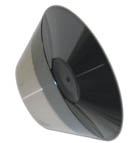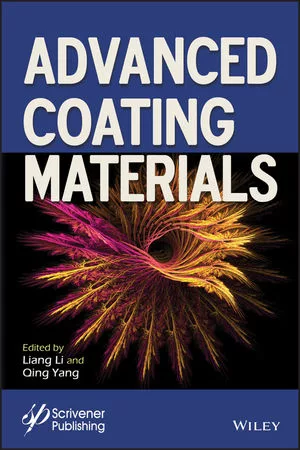Advanced Coating Technology Extends Life Of Paint Bell Cups
for Rotary Paint Atomizer Users

Not often does an investment in equipment produce a payback in six months, with direct cost savings amounting to more than 20 times the initial expenditure. But those are the results that a space-age ceramic coating for paint bell atomizers is achieving for Ford Motor Company.
This new Ford-patented coating solves the problem of limited life of the aluminum and titanium bell cups, an expensive replacement component of the paint atomizers. The process for applying the coating was developed in collaboration with the Diamonex Products Division of Morgan Advanced Ceramics. Morgan Advanced Ceramics is a leading manufacturer of innovative ceramic, glass, metal and engineered coating solutions.
Short Life of Bell Cups
While paint rotary bell atomizers have been improved over the last two decades, the abrasive wear to the bell cups has been a lingering technical problem. In addition, the useful life of these bell cups has been shortened even further by the introduction of high solids metallic paint technologies along with mica flakes to achieve brighter colors and shimmering, reflective surfaces. It is well known and documented throughout the paint community that highly pigmented and aluminum-containing surface coatings are extremely aggressive on painting equipment.
Prior to the invention of this new ceramic coating, bell cups required replacement every 3-4 months. As a result, an automotive plant utilizing 50 rotary bell atomizers would incur replacement costs for bell cups totaling approximately $300,000 per year. Moreover, bell cup failure occurs unpredictably, ruining the part's paint finish and causing the waste of 150-200 parts per year. In addition, the process of changing the bell cups causes costly production downtime.
The key technical problem to solve was to find a new bell cup coating that would extend the useful life of the bell cup, without any detrimental impact on the performance of the rotary paint atomizer.
Rotary Paint Atomizer Performance
Rotary atomizers are designed to maximize transfer efficiency, which measures the percentage of paint that ends up on the workpiece. The paint enters from the back of the bell, transfers to the wall of the bell and is electrostatically charged prior to being atomized at the edge of the spinning bell cup. The high speeds of the turbine-driven bell (spinning at 25,000 to 60,000 rpm) particulate the paint into a very fine, uniform spray. Typically, titanium bell cups are used for waterborne and powder slurry, and aluminum is used for clearcoat.
The negative electrostatic charge helps attract the paint to the workpiece, which is grounded or positively charged. An additional effect of the negative electrostatic charge of the paint particles is that it causes further atomization, as the charged particles repel each other to form an even finer cloud of spray.
The high transfer efficiency of the fine, electrostatically charged spray results in paint savings of 30-40% over electrostatic spray guns, and the cycle time for painting each workpiece is shortened. Rotary atomizers also enable a reduction in compressed air usage of more than 20%.
In addition, the high transfer efficiency of rotary atomizers ensures excellent quality and consistent results. The environment also benefits because of the reduced paint consumption and lowered VOC emissions.
Space-Age Ceramic Solution
In the effort to improve bell cup life, many tribological and surface coating solutions had been tested, with limited success. The surface coatings degraded quickly, reduced the transfer efficiency, or impaired the mechanical function of the rotary atomizers.
Ford Global Paint Engineering and Ford Scientific Research Laboratories, divisions of Ford Motor Company, took on the challenge of locating and testing a low-cost, durable surface coating that would not degrade over time, reduce overall transfer efficiency, compromise customer quality, or impair mechanical functionality of the paint equipment.
The laboratories investigated the use of Silicon Doped Amorphous Carbon Surface Coating, a material patented by Ford. With near-diamond hardness and conductivity of the base metal, this material proved to be ideally suited to the paint bell cup application.
Morgan Advanced Ceramics worked with the Ford laboratories to enhance coating and application processes. Morgan Advanced Ceramics applies the material with its own patented plasma chemical vapor deposition (CVD) process to achieve a consistent, three-micron-thick coating that does not interfere with the mechanical or electrostatic functions of the original equipment.
Dramatic Cost Savings
The success of the silicon-doped amorphous carbon surface coating has exceeded all expectations, extending the life of the atomizers almost indefinitely. Ford still has one of the original bell cups in production, in continuous and trouble-free use for over five years. The coating protects the bell cup, even with today's most abrasive paints.
The silicon-doped amorphous carbon surface coating has resulted in a significant decrease in expenditures on replacement bell cups. Ford has also documented direct improvements in painting process uniformity and vehicle quality (measured by Ford as an increase in FTT or "First Time Through" and a reduction in TGW or "Things Gone Wrong"), as well as reductions in the maintenance costs relating to paint bell cups.
Available for OEM Paint Bell Cups
Ford has teamed up with Morgan Advanced Ceramics to make this exciting ceramic coating available to original equipment manufacturers and rotary paint atomizer users. Morgan Advanced Ceramics has been granted a non-exclusive worldwide license to apply silicon-doped amorphous carbon surface coating to titanium and aluminum paint cups.
The coating represents a slightly higher initial investment (adding 15-25% to the customer cost for a new bell cup), but it extends the life of bell cups more than 1,000% - a return on investment that is hard to match.
For more information, visit www.morganadvanced ceramics.com.
Looking for a reprint of this article?
From high-res PDFs to custom plaques, order your copy today!






